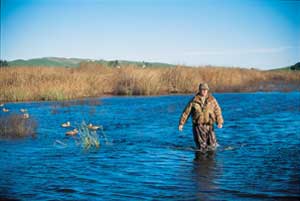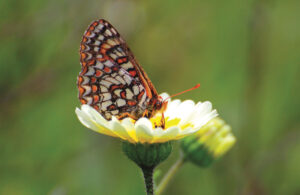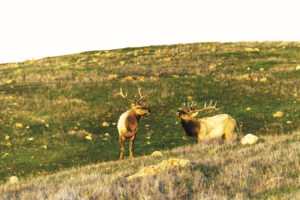East of Fairfield, Grizzly Island Road leaves Highway 12’s fast-food corridor and winds through the rolling Montezuma Hills. Cross the high bridge over Montezuma Slough and you’re on Grizzly Island: flat, wide-open Delta country, laced with sloughs. Montezuma Slough frames the island on the north and east, Suisun Bay and Roaring River Slough on the west and south. This is a prime gateway to 84,000-acre Suisun Marsh, the largest contiguous estuarine marsh in the United States.
The state Department of Fish and Game’s Grizzly Island Wildlife Area, a mosaic of marsh and upland, occupies the boomerang-shaped island’s southern third. You’ll find displays and directions for a driving tour at the entry station, but little development otherwise—no interpretive signs on the trails that take you into the wetlands, though there is much to be discovered here.
The island is best appreciated in late winter and early spring. Drive out to Parking Lot 3 and cross the road and the Grizzly Ditch footbridge, keeping an eye out for common moorhens (like coots with candy-corn beaks and white racing stripes) and river otters. Then head into the marsh along a levee. On a typical day, you won’t have much human company. But you won’t be alone.
The tules will be abuzz with resident songbirds: marsh wrens, salt marsh common yellowthroats, Suisun song sparrows (a subspecies limited to the Suisun Marsh). Listen to the yellowthroats’ signature witchity witchity witchity and the wrens’ call-and-response song duels as rivals run through their extensive repertoires. Ducks and coots will explode from just behind the green curtain; maybe an American bittern will lurch into flight. Skeins of geese drift across the wide sky, gabbling and honking.
With luck, you’ll see a telltale antler lift in the distance. Small parties of tule elk bulls hang out companionably here, munching new-grown Italian ryegrass or marsh gumplant. The drama of the fall rut is a long way off. The cows are elsewhere in the preserve, waiting for calving time. These elk are warier than their cousins at Point Reyes National Seashore: Like the waterfowl, they’re hunted.
Before there was an official wildlife area, before the farmers and hunters came, Grizzly was a marsh island—a sea of tules, surrounded by open bay and tidal channels. This means old-timers’ stories of grizzly bears from the Diablo Range swimming across Suisun Bay to feast on blackberries and rose hips are likely apocryphal. The Suisun, a subgroup of the Patwin people, plied their tule boats through the marsh, hunting waterfowl and fishing for sturgeon. (“Suisun” may mean “place of the west wind” in their language, and strong west winds do blow here in summer.)
- A hunter sets decoys on Grizzly Island. Photo by David Sanger.
Around the time of the Gold Rush, developers had grandiose plans to build cities on the edges of Suisun Marsh, but nothing came of those. For a few decades Suisun was left to the commercial waterfowl hunters who supplied urban markets. According to Anthony Arnold’s Suisun Marsh History: Hunting and Saving a Wetland, sport hunters discovered the marsh in the 1870s, when market hunters became guides for wealthy San Franciscans. Private duck clubs bought land near the Southern Pacific’s Teal and Drawbridge stations. Grizzly, meanwhile, became agricultural land where asparagus, sugar beets, oats, barley, and hogs were grown on “reclaimed” wetlands. Beginning in 1909, duck clubs acquired seasonal leases. Until a bridge was opened in 1960, hunters reached the island on a six-car cable ferry with a Model A engine.
In 1911, philanthropist-naturalist Annie Montague Alexander and her partner Louise Kellogg bought 525 acres on the island. They grew fruit trees and more than 40 kinds of vegetables and raised cattle, pigs, and poultry, but asparagus became their mainstay. The label for their AK brand asparagus featured a grizzly bear sejant, framed by cattails and backlit by a rising sun.
Alexander, benefactor of UC Berkeley’s Museum of Vertebrate Zoology, was drawn to Grizzly Island by more than the fertile soil. “We need a poet to express what we feel to be a real beauty in the tule marshes,” she wrote. Farming couldn’t distract the women from natural history: Kellogg collected the type specimen of the Suisun song sparrow on their ranch, and Alexander that of the Suisun shrew, a small, furtive insect-eater.
By 1950, when the Wildlife Conservation Board bought the core of the 8,600-acre wildlife area, the end of the farming era was in sight. As the soil grew more saline, asparagus-growing and dairying were abandoned and farmland was flooded for duck habitat. Today, apart from the state-owned area, the island is home to a patchwork of shooting clubs, whose members have been active in fighting various energy and waste-disposal schemes that would have compromised the wetlands. Both state-owned and private wetlands are cut off from tidal influence.
People who know the marsh well, like wildlife artist Rich Radigonda, have seen dramatic changes in duck populations. When Radigonda’s father took him hunting on Montezuma Slough in 1948, “there were so many ducks lying around that it didn’t matter where you were.” The Department of Fish and Game (DFG) still provides seasonal ponds and nutritious food for wintering ducks, but events outside its control have reduced waterfowl numbers. “We used to have a million pintail winter here in the ’60s and early ’70s,” recalls manager Pat Graham. Hard hit by subsequent drought in its prairie nesting grounds, that species has never regained its one-time abundance. Also, more ducks and geese began wintering in the Sacramento Valley in the 1990s, when rice farmers there began flooding their fields after harvest, rather than burning the stubble.
Graham says the last aerial count, in March 2004, tallied 53,201 ducks on the island. Add 1,300 Canada geese and a few snows, and that’s still far below former records. But populations are up a bit: Last season, hunters had the highest take since the mid-1990s.
The pintails and most other ducks head north in spring, but mallards, gadwall, and cinnamon teal stay to nest. Grizzly Island was once a veritable mallard factory. Fieldwork in the 1980s documented densities of up to 227 nests per square kilometer. But California Waterfowl Association biologist Dan Loughman says mallard productivity fell in the late ’90s and has stayed low. Predation is a big part of the problem, says Graham: “Everything loves a duck.” Skunks, gopher snakes, and ravens go for the eggs; otters take the ducklings. And DFG lacks the resources to control them. Management for pheasant production may have made nest predator access easier by creating irrigated strips in what had been contiguous dry upland. Graham and Loughman also say encroachment by perennial peppergrass and phragmites has diminished habitat quality.

- About 90 tule elk, descendants of eight introduced in 1977,live on Grizzly Island. Hunters eliminated the island’s original elk inthe 1860s. Today, the herd is healthy enough to support a two-weekhunting season. Photo by Jeremy Todoroff.
The tule elk have experienced a different cycle. This smallest subspecies of North American elk was historically abundant in the Suisun Marsh. The first European encounter came in 1837, when a British exploring party bludgeoned an elk to death with an oar, then ate the animal, complaining that the meat was tough. Other hunters followed, and by the 1860s tule elk had been extirpated from the marsh. By 1875 the entire population had collapsed to a few individuals in the San Joaquin Valley.
That remnant was subsequently protected and became a source for translocation to now-empty habitat. In 1977, eight elk from Kern County were moved to Grizzly Island, founding the current population of about 90. “Grizzly Island is a very productive habitat, and they increase very rapidly,” says Dale McCullough, retired UC Berkeley professor and author of the definitive tule elk study. The highest year-end count was 128 in 1989. There’s little predation (coyotes may take the occasional calf, but that’s rare), no black-tailed deer or cattle to compete for food or harbor disease, and abundant forage. “These are the fattest, healthiest elk in the state,” says Joe Hobbs, a Sacramento-based DFG biologist who heads the statewide elk program.
Although the tule elk squeezed through the genetic bottleneck of near extinction without accumulating dangerous mutations, genetic diversity remains a potential problem. “Tule elk have the largest breeding group size of any North American elk subspecies because they live in big open grasslands,” McCullough says. Bulls defend harems four times larger than those of the forest-dwelling Roosevelt elk. But one or two bulls may do all the breeding, reducing genetic diversity to less than half that of Roosevelt or Rocky Mountain elk. That’s why state wildlife managers move tule elk from one isolated population to another.
But some elk have their own ideas. Wildlife area biologist Helayna Pera says several bulls were moved from the Concord Naval Weapons Station to Grizzly Island two years ago: “We had at least one swim back across [Suisun] Bay to Concord.” Another crossed Interstate 680 and took up residence near a Carl’s Junior.
McCullough says the island’s tule elk require “some kind of control—elk will trash their habitat, just eat it up.” Grizzly Island has a two-week elk-hunting season in September. But DFG has revised earlier estimates of the wildlife area’s carrying capacity for elk and decreased the number of hunting tags accordingly, from 40 in recent seasons to nine last year. The current goal is to build the herd back up to about 140 animals, though Hobbs says the island might support a population of 200 or more.
There’s an annual rhythm to the elks’ lives. Bulls shed their antlers in March. Cows give birth in spring, about the time the winter waterfowl depart. By summer the bulls’ racks are back, sheathed in velvet that’s rubbed off against trees, posts, or power poles. Fall brings the rut, signaled by the bugling of the bulls, which, McCullough writes, “has a distinct throaty roar, with a pronounced tin horn quality.”
Grizzly Island has attractions beyond elk and ducks, of course. Many of the marsh birds are present year-round, and wintering and migrant shorebirds pass through. This is also a great place to see raptors, attracted by abundant small rodents.
In late winter and early spring, white-tailed kites, red-tails, prairie falcons, and maybe a lingering rough-legged or ferruginous hawk work the skies over the marsh. You’re sure to see northern harriers—gray males, brown females and juveniles—flying low and rocking back and forth, listening for the rustle of a vole. Late in the afternoon, you can watch the changing of the guard as short-eared owls emerge from their roosts to go after those same voles.
These medium-size owls are a California species of special concern, and they nest here, on the ground in concealing vegetation. Their numbers rise and fall with those of their rodent prey, which they hunt at dawn and dusk. Males court their mates with an elaborate sky-dance, punctuated by tooting calls and wing-claps. In his Field Guide to Owls of California and the West, Hans Peeters writes: “It makes for a wondrous experience to see a dozen or more of these birds, 200 feet or so up in the cloud-dappled sky, engage in a stately airborne ballet.”
Grizzly Island and its neighboring waterways are home to one of California’s largest river otter populations, and the otters leave clear signs of their presence: piles of droppings—”spraints”—at the water’s edge, recognizable by their heavy content of crayfish shell. Be patient and you might see a sleek head popping out of the water, or the antics of a family group.

- A female northern harrier with prey. Grizzly Island is agreat place to see raptors, from harriers to owls, all attracted by theisland’s dense rodent populations. Photo by Rick Lewis.
Whenever I’ve visited this place, there’s always been something unexpected. Once it was a near-hatchling western pond turtle, the size of a half dollar, paddling down a canal. On other occasions, minuscule butterflies-western pygmy-blues, the smallest North American species-in an ankle-high patch of pineapple weed, or two shaggy coyotes regarding me from across a field.
Grizzly Island, a managed environment with a long history of human use and abuse, is far from pristine. But the wildlife area—apart from providing targets for hunters—protects habitat that might otherwise have been lost to development, sheltering a broad range of marsh and upland species. This place repays the receptive visitor. Be patient, and prepare to be surprised.
Getting There:
From Interstate 80 north, take Highway 12 east. Turn right on Grizzly Island Road and proceed 9.5 miles to the entry station to register and pay a day-use fee. Auto tour directions are available from the Department of Fish and Game. The wildlife area is closed to nonhunters from August through mid-September and October through January; it’s also subject to closing in winter when roads are flooded. For information, call (707)425-3828, weekdays, 8 a.m.-4:30 p.m.

.jpg)




